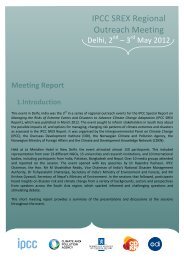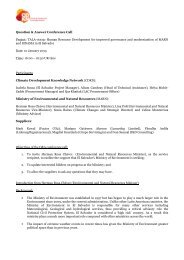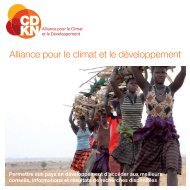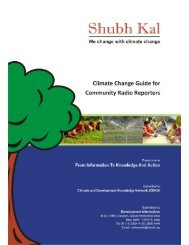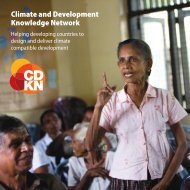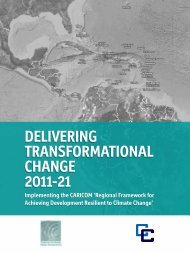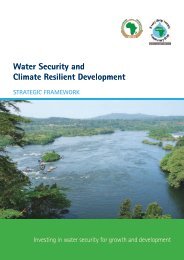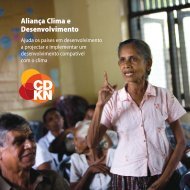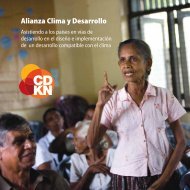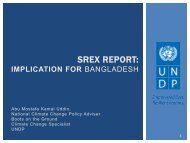Meeting Report - CDKN Global
Meeting Report - CDKN Global
Meeting Report - CDKN Global
- No tags were found...
Create successful ePaper yourself
Turn your PDF publications into a flip-book with our unique Google optimized e-Paper software.
accounting for the highest proportion (54.6%) of total loss due to weather-‐ and climate-‐related disasters. On wildfires, more frequent wildfires are probable (an increase in frequency of 60% for a temperature increase of 3°C) in much of South America. In most of central and northern Mexico, the vegetation of arid regions could replace the current semi-‐arid vegetation. Due to the interrelated nature of forest fires, deforestation, drought, and climate change, isolating one of the processes fails to describe the complexity of the whole picture. Even though it was included on the SREX report, Nobre presented some impacts of climate extremes in the megacity of São Paulo, showing that events of intensive rainfall in the city of São Paulo are becoming more frequent during the last 70 years, together with a reduction of light precipitation. Projected changes in rainfall extremes suggest an increase in the frequency and intensity of heavy precipitation and on warm nights and days. These changes together with and urban expansion may be the cause of a projected increase in the risk of landslides and flood–related leptospirosis in the city. Nobre also explains that climatic disasters account for the majority of natural disasters in Central America, with most of its territory located in tropical and equatorial areas. Low-‐lying states are especially vulnerable to hurricanes and tropical storms. In October 1998, Hurricane Mitch, one of the most powerful hurricanes of the tropical Atlantic Basin of the 20th century, caused direct and indirect damages to Honduras of US$ 5 billion, equivalent to 95% of Honduras’ 1998 GDP. Some literature indicates that hurricane losses, when corrected for population and wealth in Latin America and the Caribbean, have not increased since the 1940s; and that increasing population and assets at risk are the main reason for increasing impacts. Dr. Ursula Oswald-‐Spring discuss disaster risk management in Latin America, and explains that increasing exposure of people and assets is the major cause of changes in disaster losses, especially when people lack insurance and governmental support, and effective risk management and adaptation are tailored to regional and local needs and circumstances. Economic losses from climate-‐related disasters have increased, with large spatial and interannual variation, but are higher in industrialized countries, while fatalities are higher in developing countries. Examples on managing the risks in Central America are the hurricanes in Mexico, Central America and the Caribbean. On those regions, while risk factors are population growth and increasing property value, as well as higher storm surge with sea level rise. Risk management for adaptation include better forecasting, warning systems, stricter building codes and regional risk pooling. This is important, considering that it is likely an increase in average wind speed and associated heavy rainfall in Central America, but the uncertainties are still high on what would happen with tropical cyclone trends in the future on the region. Other important aspect raised by Dr. Oswald-‐Spring is the gender vulnerability and women’s discrimination increase vulnerability of exposed communities: even non-‐extreme events can have extreme impacts in loss of lives and livelihood. For instance considering drought in the context of food security in the dry lands, risk factors include more variable rain, ecosystem degradation, hotter days, discrimination of women and poor health and education conditions. Risk management options include improved water management, sustainable farming practice, drought-‐resistance crops and drought forecasting. In addition, indigenous people are highly vulnerable and at risks during extreme events. In Central America, social and environmental vulnerability assessments include a linking local to global actors and responsibilities using both top-‐down and bottom-‐up approaches. She also mentions the need for information and training on vulnerability, exposure, climate extremes, disaster risk management, and resilience-‐building help people reducing risks, and get prepared to unknown risks. At the ends, se also explained that there are strategies 8



